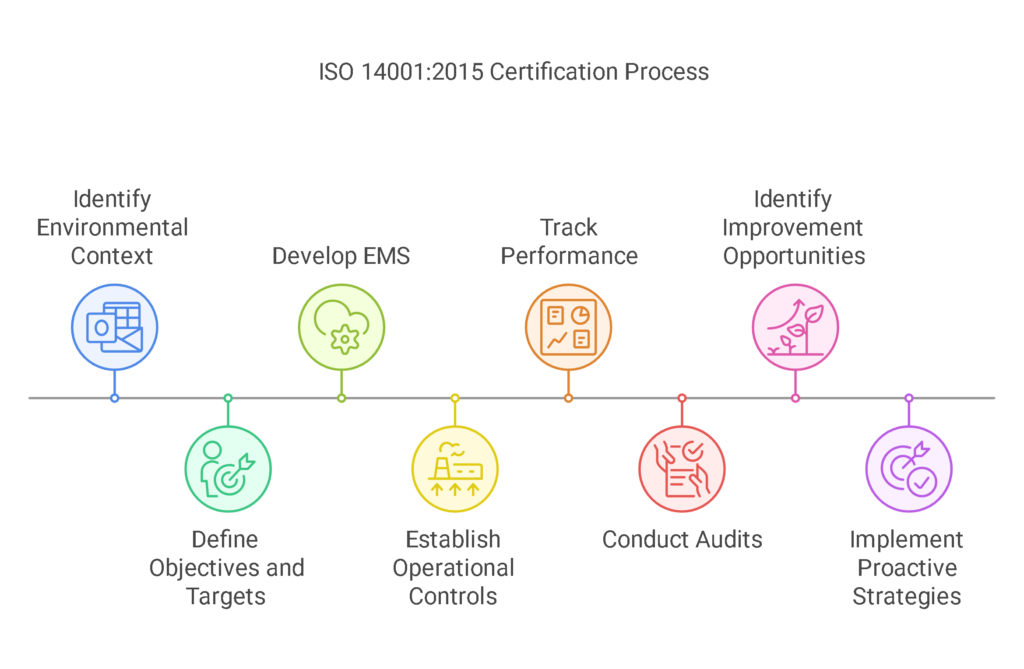ISO 14001:2015 Environmental Management Systems – Requirements, Benefits & Certification Guide

Introduction
Environmental responsibility is no longer optional—it’s a necessity. ISO 14001:2015 is an internationally recognized standard for Environmental Management Systems (EMS) that helps organizations reduce their environmental impact, comply with regulations, and improve sustainability practices.
Understanding ISO 14001:2015
ISO 14001:2015 provides a framework for businesses to manage their environmental responsibilities. It has evolved to align with modern environmental concerns, ensuring businesses adopt sustainable practices while maintaining efficiency.
Why ISO 14001:2015 Certification Matters?
Benefits for Businesses
- Reduces environmental footprint
- Enhances regulatory compliance
- Improves operational efficiency
- Strengthens corporate reputation
- Lowers waste management costs
Industry-Specific Advantages
- Manufacturing: Reduces emissions and waste
- Construction: Ensures sustainable resource usage
- Healthcare: Manages hazardous materials safely
- Retail: Promotes sustainable supply chains
Key Principles of ISO 14001:2015
- Environmental Policy – Establishing clear sustainability goals
- Leadership Commitment – Involvement of top management in environmental initiatives
- Risk-Based Thinking – Identifying potential environmental risks and mitigating them
- Legal and Regulatory Compliance – Ensuring adherence to environmental laws
- Continuous Improvement – Commitment to ongoing environmental enhancement
ISO 14001:2015 Requirements
To achieve certification, organizations must meet the following requirements:
1. Context of the Organization
- Identify environmental risks and opportunities
- Understand external environmental factors
2. Planning and Risk Assessment
- Define objectives and targets for sustainability
- Assess environmental risks and compliance obligations
3. Implementation and Operation
- Develop an Environmental Management System (EMS)
- Establish operational controls to minimize impact
4. Monitoring and Measurement
- Track environmental performance using KPIs
- Conduct periodic environmental impact assessments
5. Performance Evaluation
- Implement internal audits and reviews
- Ensure corrective actions for non-compliance
6. Continuous Improvement
- Identify opportunities for enhancing environmental performance
- Implement proactive environmental strategies

Common Challenges and How to Overcome Them
- Lack of Employee Engagement → Conduct environmental training programs
- Difficulty in Documentation → Use structured EMS documentation tools
- Regulatory Complexity → Stay updated with environmental laws and guidelines
How QA Compliance Assessment Can Help?
At QA Compliance Assessment, we specialize in helping businesses achieve ISO 14001:2015 certification with expert guidance, training, and auditing services. Our tailored solutions ensure compliance with environmental standards while improving overall sustainability.
Conclusion
ISO 14001:2015 is an essential certification for businesses aiming to reduce their environmental impact and comply with sustainability regulations. By implementing its principles, organizations can achieve long-term environmental and economic benefits. Partner with QA Compliance Assessment to simplify your journey towards environmental excellence.
FAQ
The timeframe depends on the organization’s size and preparedness but typically ranges from 3 to 6 months.
No, but it is highly recommended for companies looking to enhance sustainability and regulatory compliance.
Costs vary based on the size, complexity, and certification body used.
Yes, businesses of all sizes can implement an EMS and achieve certification.
Certification is valid for three years, with annual surveillance audits required.

